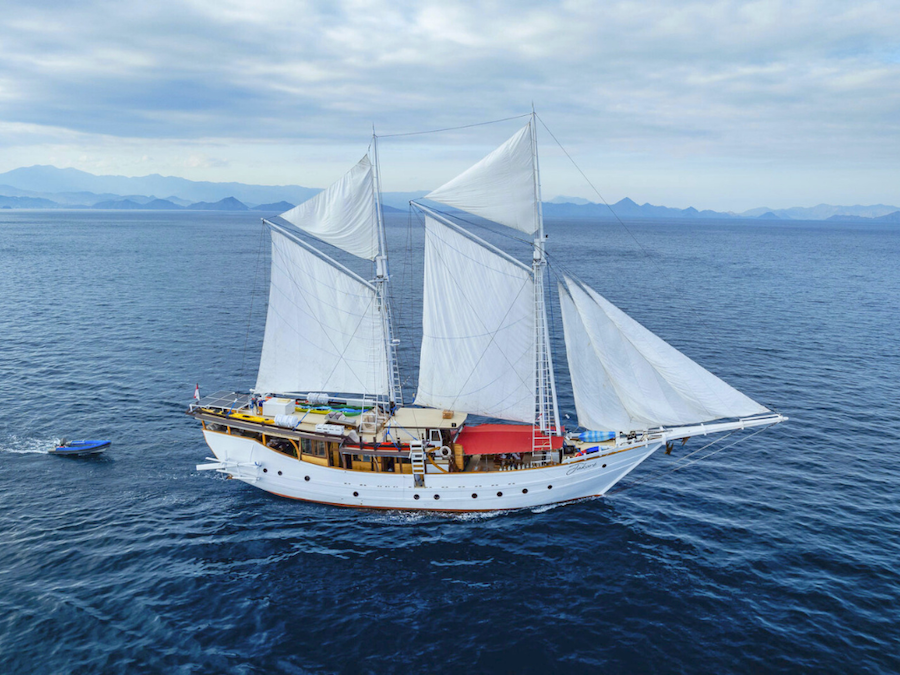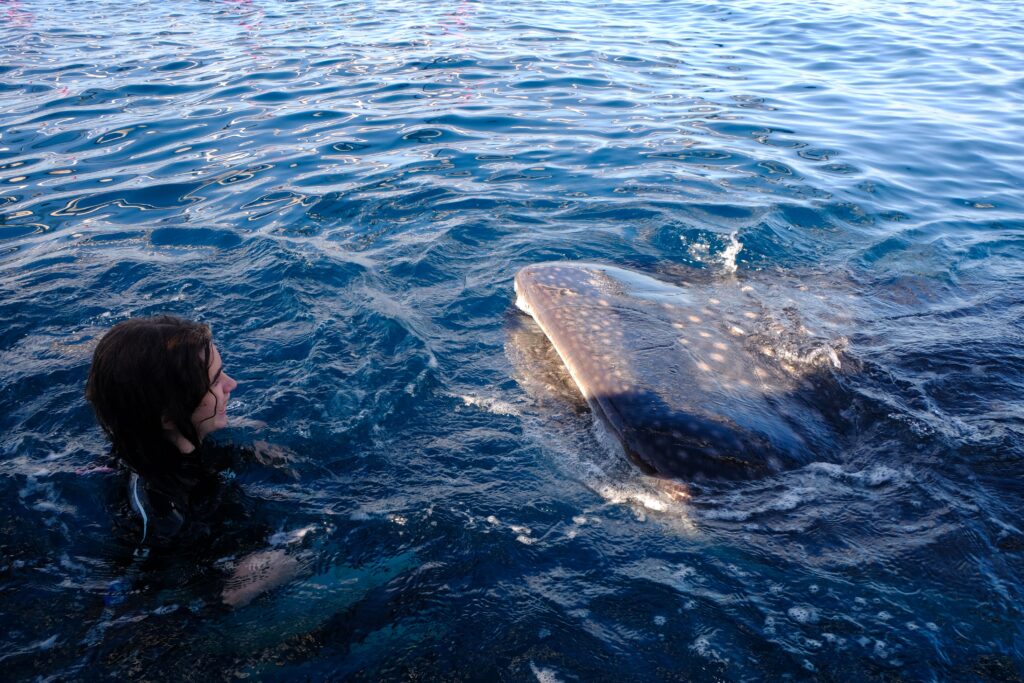
This September, the Jakare returned to Bira, in South Sulawesi, for nearly three weeks of intense maintenance. In the very place where she was originally built by Bugis master boatbuilders—guardians of a centuries-old tradition—the Jakare went back to her roots. To better understand the improvements, we sat down with François, the passionate owner of the vessel.
Why return to Bira for the works?
Bira is the cradle of the phinisi. Here, every wooden boat is unique, built without blueprints, straight from the mind and heart of the shipwrights. It’s on these beaches that the Jakare was born, and coming back here is a way to reconnect with that tradition (and to continue working with artisans we deeply admire and respect). It’s not just about maintaining a boat—it’s about staying connected to its living history.
The Upgrades

🔧 New Yanmar Generator
The generator is the beating heart of a boat’s electrical system. With our new Yanmar, we’ve gained reliability, performance, and especially fuel efficiency. That’s crucial, because a more efficient generator means less fuel burned—and therefore a reduced carbon footprint. It also brings us one step closer to acquiring a nitrox membrane system next year, which will add even more comfort and safety!
But the most impressive change is the comfort it brings: the vibrations are so reduced that you hardly even feel it anymore. For our guests, this is a real improvement—more silence, more serenity… it’s almost like forgetting the generator is even running.
🌊 Replacing the Two Masts and Reinforcing the Rigging
This was undoubtedly the most spectacular part of the maintenance. Replacing the masts of a phinisi is a monumental task. The timber had been carefully selected and left to dry for nearly a year to ensure strength and longevity, then worked and prepared by the craftsmen so everything was ready when the boat arrived.
It took Pak Daeng’s team—eight men working full-time—two entire weeks to dismantle the old masts, hoist and install the new ones, and secure every fitting with precision. The main masts each weigh over half a ton, and all of this was done without a crane! Just pulleys, ropes, and traditional know-how. The ingenuity of these craftsmen is truly humbling.
We did have the option to replace them with steel masts, like some other boats do. They’re more expensive to fabricate but last much longer, sparing the need for regular replacements. Still, I chose to remain faithful to Jakare’s spirit: keeping wooden masts, as tradition demands. Of course, it means we’ll likely have to replace them again in about ten years. But that living cycle is exactly what gives these boats their soul.
Masts are not just structural elements. On a phinisi, they embody the identity and elegance of the vessel. Even though Jakare mostly runs on her engine, the masts balance the hull, reinforce safety, and contribute to that unmistakable silhouette that delights our guests every time they step on board.
Replacing the masts—together with strengthening all the rigging and adding new stainless steel fittings—isn’t just an investment in Jakare’s durability. It’s also an act of respect for the Bugis heritage. Today, she stands taller and prouder than ever, ready for new voyages.
🪢 New Standing Rigging (12 mm Cables)
The rigging—those cables that hold the masts in place—is technical detail, yes, but absolutely vital for the boat’s reliability. We never compromise on safety, so we chose the highest quality imported cables.
🔋 Switch to Lithium Batteries
This step was inevitable given the recent advances in technology. We switched to lithium batteries: they’re more powerful (holding charge much longer), recharge faster, and last far longer—over 5,000 cycles if properly maintained. And they’re certainly more environmentally friendly than the old lead-acid batteries.
In practice, this means we can go longer without running the generators—more silence, more comfort for our guests. It’s a big plus for both the passenger experience and our ecological commitment.
And by reducing generator use, we also lower our carbon footprint. It’s a technical upgrade, but also a meaningful step toward navigating more sustainably through these precious marine ecosystems.
🏗️ Installation of a New Crane
Ah, now this was quite an adventure (laughs)! But also a very personal project. The crane was designed and calculated by a close engineer friend in Kuala Lumpur, then built in Surabaya. I followed every step closely, from the drawings to the fabrication. It was important to me that it be perfectly adapted to Jakare—strong, reliable, and built to last.
It’s not just a tool for lifting heavy equipment. It will allow us to bring the tender safely on board during long crossings, improving both safety and efficiency. And it will greatly help with handling kayaks during our dedicated kayak cruises, like the ones we’re currently running in Sulawesi and the Togean Islands. That’s a big help for the crew, and a smoother experience for our guests.
Interestingly, the same company also manufactured the new anchors for Jinggo Janggo, based on my own designs. I like the idea that each technical element of our boats carries a story and a personal touch.
⚙️ New Reducer for the Windlass
The windlass is what allows us to raise the anchor. Guests who’ve sailed with us before will remember that this used to be a bit of a tricky moment… and especially noisy, waking everyone very early in the morning with all the jolts and clatter (laughs).
With the new reducer, we have more power, which means more safety. It’s quicker, smoother, and far quieter. The windlass is a key safety component, and we give it the utmost care.
✨ Even Softer Nights On Board ✨
We’ve upgraded all the cabin mattresses with natural Indonesian latex toppers. It’s a real game-changer. Latex adapts perfectly to the body, supports the spine, absorbs vibrations, and reduces pressure points. The result: fewer micro-awakenings at night, deeper sleep, and waking up with the true feeling of having recovered.
That’s essential, because life on board is intense—dives, excursions, emotions… All of it requires a lot of energy. To fully enjoy it, nothing beats a good night’s sleep. With these new mattresses, nights on Jakare are genuinely softer, and our guests can wake up full of energy for another day of adventure.
There’s also an ecological dimension I care about: natural latex is a renewable, sustainable material, unlike synthetic foams. It’s another small step to keep Jakare aligned with our vision—offering maximum comfort to our guests while respecting the environment that welcomes us.
🚿 Crew Bathroom Renovated
We installed brand-new tiles in the crew’s bathroom. It may seem like a detail, but it’s important for their comfort. Crew well-being is the foundation of a positive atmosphere on board. And honestly, the bathroom looks so nice that guests might even be jealous! (smiles)
In fact, this renovation is a test. For 2026, we’d like to redesign the guest bathrooms as well—with the same focus on modernity, comfort, and aesthetics. The goal is to offer an even higher level of refinement, while keeping Jakare’s warm authenticity. This first project is an inspiring step in that direction.
Ready for New Adventures

Today, Jakare is ready. Safer, more efficient, more comfortable… and still true to her soul. A phinisi is not just a boat—it’s a living being. Each maintenance is like caring for it, so it can continue to carry dreams and travelers across the Indonesian seas.
And a heartfelt thank you to Audrey and our entire crew—without whom none of this would have been possible!
Jakare awaits you—renewed, radiant, and ready to write the next chapter of her story at sea.









Read More